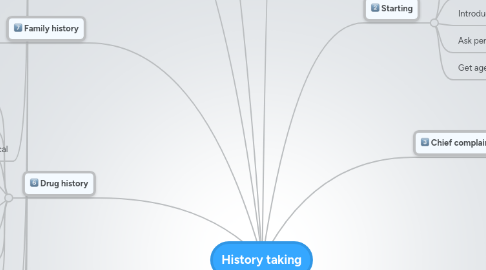
1. Family history
1.1. Ask about any disease that runs in the family
1.2. Get information about 1st degree relatives
1.2.1. How old are the parents or how did they die
1.2.2. Siblings
1.2.3. Children
2. Drug history
2.1. All drugs the patient takes
2.2. Why
2.3. Dose
2.4. Frequency
2.5. Adherence
2.6. Prescribed or over the counter
2.7. Last taken
2.8. Allergy
3. Social and occupational history
3.1. Understanding the patient's context & social history
3.1.1. Occupation
3.1.2. Upbringing & education
3.1.3. Finance
3.1.4. Community support
3.1.5. Diet
3.1.6. Exercise
3.1.7. Relationship statues
3.1.8. Home life
3.1.8.1. Who lives with you
3.1.8.2. Who takes care of you
3.1.8.3. Home problems
3.1.8.4. Abuse
3.1.9. Leisure activities
3.1.10. Substance misuse
3.1.10.1. Tobacco
3.1.10.2. Alcohol
3.1.10.3. Street drugs
3.1.11. Sexual history
3.1.12. Beliefs
4. Systematic inquiry
4.1. General symptoms
4.1.1. Well being
4.1.2. appetite
4.1.3. wight change
4.1.4. energy
4.1.5. sleep
4.1.6. mood
4.2. Cardio
4.2.1. chest pain on exertion
4.2.2. shortness of breath
4.2.2.1. lying flat
4.2.2.2. at night
4.2.2.3. on minimal exertion
4.2.2.4. palpitation
4.2.2.5. pain in legs on walking
4.2.2.6. ankle swelling
4.3. Respiratory
4.3.1. Shortness of breath
4.3.2. cough
4.3.3. wheeze
4.3.4. sputum production (color, amount)
4.3.5. Blood in sputum
4.3.6. chest pain due to inspiration of cough
4.4. Gastrointestinal
4.4.1. Mouth (oral ulcers, dental issues)
4.4.2. Difficulty or pain swallowing
4.4.3. Nausea and vomiting
4.4.4. indigestion
4.4.5. heartburn
4.4.6. abdominal pain
4.4.7. change in bowl habit
4.4.8. change in color of stool
4.5. Genitourinary
4.5.1. Pain passing urine
4.5.2. Frequency passing urine (at night?)
4.5.3. Blood in the urine
4.5.4. Libido
4.5.5. Incontinence
4.5.6. Sexual partners
4.5.7. Men
4.5.7.1. Prostatic symptoms (like difficulty starting - hesitancy)
4.5.7.2. Poor stream or flow
4.5.7.3. terminal dribbing
4.5.7.4. urethral discharge
4.5.7.5. erectile difficulty
4.5.8. Women
4.5.8.1. Last menstrual period (pregnancy)
4.5.8.2. timing and regularity of periods
4.5.8.3. length of periods
4.5.8.4. abnormal bleeding
4.5.8.5. vaginal discharge
4.5.8.6. contraception
4.5.8.7. pain during intercourse
4.6. Neurological
4.6.1. headaches
4.6.2. dizziness (vertigo or light-headed?)
4.6.3. faints
4.6.4. fits
4.6.5. altered sensation
4.6.6. weakness
4.6.7. visual disturbance
4.6.8. hearing problems
4.6.9. memory and concentrating problems
4.7. Musculoskeletal
4.7.1. Joint pain, stiffness or swelling
4.7.2. Mobility
4.7.3. Falls
4.8. Skin
4.8.1. Bleeding or bruising
4.8.2. skin rash
4.9. Endocrine
4.9.1. Heat or cold intolerance
4.9.2. change in sweating
4.9.3. excessive thirst
5. Past medical history & surgery
6. History of present complaint
6.1. ask about each symptom to get details
6.2. FIFE
6.2.1. Feeling
6.2.2. Ideas
6.2.3. Functioning
6.2.4. Expectations
6.3. Pain assessment (SOCRATES)
6.3.1. Site
6.3.2. Onset
6.3.3. Character
6.3.4. Radiation
6.3.5. Associated symptoms
6.3.6. Timing
6.3.6.1. Duration
6.3.6.2. course
6.3.6.3. pattern
6.3.7. exacerbating and relieving factors
6.3.8. severity
6.3.9. effects on life style
